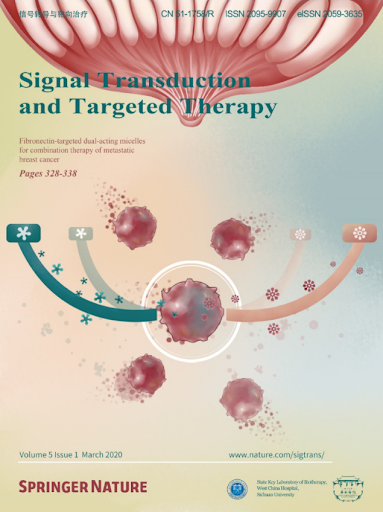Reprogramming of cancer metabolism via photoresponsive nano-PROTAC enhances pyroptosis-mediated immunotherapy.
IF 52.7
1区 医学
Q1 BIOCHEMISTRY & MOLECULAR BIOLOGY
引用次数: 0
Abstract
Photodynamic therapy (PDT) induces tumor cell pyroptosis, a form of programmed cell death that triggers antitumor immunity. However, high glucose metabolism and hypoxic conditions in the tumor microenvironment (TME) limit PDT efficiency and impair effector cell function. Here, we propose a cancer metabolic reprogramming-enabling photoresponsive nanoproteolysis-targeting chimera (Nano-PROTAC; NanoTAC), derived from the supramolecular self-assembly of drug conjugates that bridge a PROTAC targeting hexokinase II (HK2) and a photosensitizer via a biomarker-cleavable linker. In a triple-negative breast cancer (TNBC) model, NanoTAC initially silences PROTAC activity and accumulates in tumor regions, where it undergoes linker cleavage in response to enzymatic biomarkers. Upon photoirradiation, PDT-induced pyroptotic cell death promotes the release of tumor-associated antigens (TAAs) and damage-associated molecular patterns (DAMPs) to drive the cancer-immunity cycle. Concurrently, targeted protein degradation (TPD) via PROTACs counteracts glucose and oxygen consumption in the TME, ultimately potentiating pyroptosis-mediated photoimmunotherapy. This combination therapy achieves a high rate of complete regression in primary TNBC and confers adaptive immunity to prevent metastasis and recurrence. Our study presents a rationally designed nanomedicine that integrates PDT and PROTACs, shedding light on strategies for more effective cancer immunotherapy.通过光反应纳米protac重编程癌症代谢增强焦热介导的免疫治疗。
光动力疗法(PDT)诱导肿瘤细胞焦亡,一种触发抗肿瘤免疫的程序性细胞死亡形式。然而,肿瘤微环境(TME)中的高糖代谢和缺氧条件限制了PDT的效率并损害了效应细胞的功能。在这里,我们提出了一种癌症代谢重编程的光响应性纳米蛋白水解嵌合体(Nano-PROTAC; NanoTAC),它来源于药物偶联物的超分子自组装,通过生物标记物可切割的连接物连接靶向己糖激酶II (HK2)的PROTAC和光敏剂。在三阴性乳腺癌(TNBC)模型中,NanoTAC最初沉默PROTAC活性并在肿瘤区域积累,在那里它响应酶生物标志物进行连接物切割。在光照射下,pdt诱导的热腐细胞死亡促进肿瘤相关抗原(TAAs)和损伤相关分子模式(DAMPs)的释放,从而驱动癌症免疫周期。同时,靶向蛋白降解(TPD)通过PROTACs抵消TME中的葡萄糖和氧气消耗,最终增强焦热介导的光免疫治疗。这种联合治疗在原发性TNBC中实现了高完全消退率,并赋予适应性免疫以防止转移和复发。我们的研究提出了一种合理设计的纳米药物,结合PDT和PROTACs,为更有效的癌症免疫治疗策略提供了新的思路。
本文章由计算机程序翻译,如有差异,请以英文原文为准。
求助全文
约1分钟内获得全文
求助全文
来源期刊

Signal Transduction and Targeted Therapy
Biochemistry, Genetics and Molecular Biology-Genetics
CiteScore
44.50
自引率
1.50%
发文量
384
审稿时长
5 weeks
期刊介绍:
Signal Transduction and Targeted Therapy is an open access journal that focuses on timely publication of cutting-edge discoveries and advancements in basic science and clinical research related to signal transduction and targeted therapy.
Scope: The journal covers research on major human diseases, including, but not limited to:
Cancer,Cardiovascular diseases,Autoimmune diseases,Nervous system diseases.
 求助内容:
求助内容: 应助结果提醒方式:
应助结果提醒方式:


